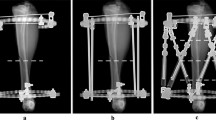Abstract
Introduction
Limb reconstruction using circular frames requires complex accurate measurements to achieve correction of mechanical bone axis. Inadequate imaging could ultimately lead to poor clinical outcome. Therefore, radiographs should be obtained in a standardised manner to yield accurate results. Our aim is to improve the effectiveness of post-operative imaging by obtaining precise examinations and improving the accuracy of frame correction; therefore, reducing technical repeats, radiation exposure, time waste in clinic, and achieving cost effectiveness.
Methods
We implemented a simple technique for obtaining adequate imaging using standard X-ray equipment. This technique was introduced to the radiographers in the radiology department to image patients with circular frames. Images were taken by obtaining a field of view using the X-ray machine cone of light that is orthogonal to the location of interest in both the antero-posterior (AP) and lateral planes. We compared the quality of radiographs, number of repeated X-rays and radiation dose both before and after implementing our protocol
Results
We assessed 54 consultations before and 63 consultations after the implementation of our protocol. The results showed a reduction in inadequate radiographs from 78% to 13% department at Addenbrooke’s Hospital at a statistical significance of p < 0.00001. In addition, we found a potential radiation dose reduction of 2.7–0.32mSev between the two cohorts. Our results indicate that there would also be a reduction in the cost to the department as well as time spent repeating inaccurate radiographs.
Conclusion
We have been able to achieve a significant improvement in the quality of post-operative radiographic imaging and have expanded its use to adult frame patients with a background of traumatic or infectious aetiologies.







Similar content being viewed by others
References
Tresley J, Schoenleber SJ, Singer AD, Clifford P (2015) “Ilizarov” external fixation: what the radiologist needs to know. Skeletal Radiol 44(2):179–195
Kani KK, Porrino JA, Chew FS (2019) External fixators: looking beyond the hardware maze. Skelet Radiol. https://doi.org/10.1007/s00256-019-03306-w
Kanellopoulos AD, Mavrogenis AF, Kanellopoulos ND, Magnissalis EA, Papagelopoulos PJ (2009) A guide frame for the Taylor Spatial Frame. J Orthop Trauma 23(7):537–540
Gantsoudes GD, Fragomen AT, Rozbruch SR (2010) Intraoperative measurement of mounting parameters for the Taylor Spatial Frame. J Orthop Trauma 24(4):258–262
Menakaya C, Rigby A, Hadland Y, Barron E, Sharma H (2014) Fracture healing following high energy tibial trauma: Ilizarov versus Taylor Spatial Frame. Ann R Coll Surg Engl 96(2):106–110
Liu Z, Tang G, Guo S, Cai B, Li Q (2018) Effects of Taylor Spatial Frame on tumors and tumor-like lesions with pathological fractures of lower extremities. Pak J Med Sci 34(2):440
Arvesen JE, Tracy Watson J, Israel H (2017) Effectiveness of treatment for distal tibial nonunions with associated complex deformities using a hexapod external fixator. J Orthop Trauma 31(2):e43–e48
Wright J, Sabah SA, Patel S, Spence G (2017) The silhouette technique: improving post-operative radiographs for planning of correction with a hexapod external fixator. Strateg Trauma Limb Reconst 12(2):127–131
Mar WA, Schilling JH, Lomasney L, Chen E, Taljanovic MS, Lowe J (eds) (2019) Radiologic evaluation of lower leg, ankle, and foot fracture fixation hardware Seminars in musculoskeletal radiology. Thieme Medical Publishers, New York
Deakin D, Rolands T (2007) A frame-mounted X-ray guide for the Taylor spatial frame. Ann R Coll Surg Engl 89(7):729
Park D, Bradish C (2011) An intraoperative method of calculating the mounting parameters for the Taylor Spatial Frame using the image intensifier. Ann R Coll Surg Engl 93(3):260–261
Sokucu S, Demir B, Lapcin O, Yavuz U, Kabukcuoglu YS (2014) Perioperative versus postoperative measurement of Taylor spatial frame mounting parameters. Acta Orthop Traumatol Turc 48(5):491–494
Kucukkaya M, Karakoyun O, Armagan R, Kuzgun U (2011) Calculating the mounting parameters for Taylor spatial frame correction using computed tomography. J Orthop Trauma 25(7):449–452
Acknowledgements
We would like to thank the radiographers and the QSIS department at Addenbrooke’s Hospital.
Funding
There is no funding source.
Author information
Authors and Affiliations
Corresponding author
Ethics declarations
Conflict of interest
The authors declare that they have no conflict of interest.
Ethical approval
Ethical approval was granted by the Cambridge University Hospital QSIS department.
Human and animal rights
This article does not contain any studies with human participants or animals performed by any of the authors.
Informed consent
Informed consent was obtained from all individual participants included in the study. Additional informed consent was obtained from all individual participants for whom identifying information is included in this article. Written consent was obtained from individual participants whose anonymised images were used in the study.
Additional information
Publisher's Note
Springer Nature remains neutral with regard to jurisdictional claims in published maps and institutional affiliations.
Rights and permissions
About this article
Cite this article
Al-Uzri, M., Thahir, A., Abdulkarim, A. et al. Improving radiographic imaging for circular frames: the Cambridge experience. Arch Orthop Trauma Surg 140, 1965–1970 (2020). https://doi.org/10.1007/s00402-020-03451-1
Received:
Published:
Issue Date:
DOI: https://doi.org/10.1007/s00402-020-03451-1




